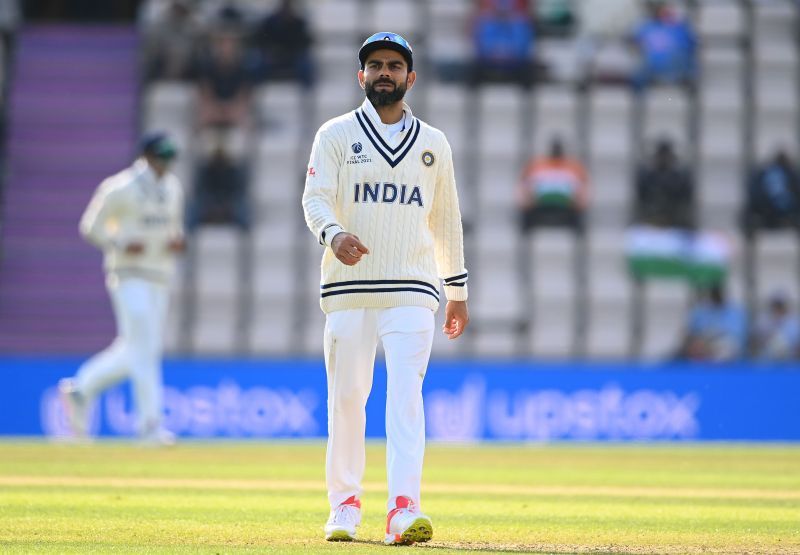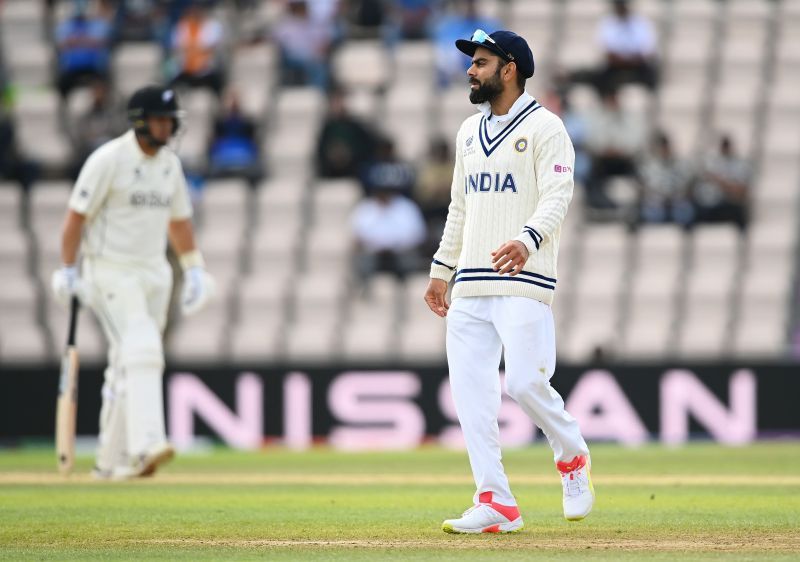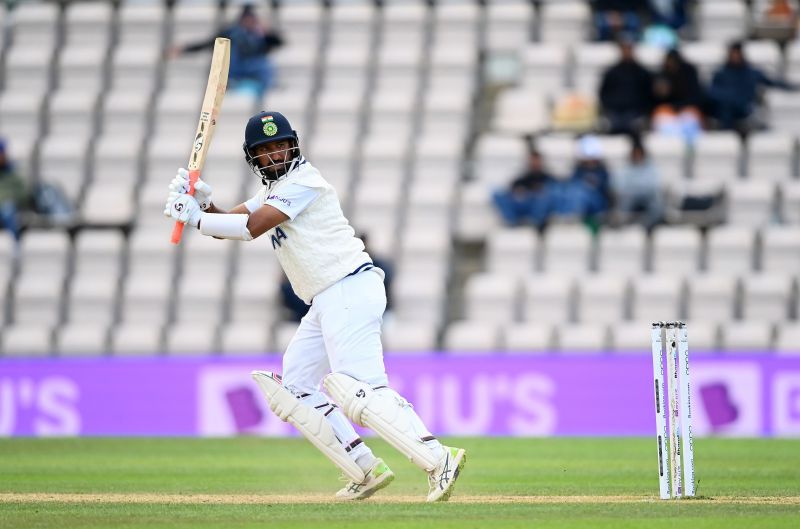
India's lack of bravery and courage mars historic occasion

A few weeks ago, when India rocked up on British shores, their arrival was greeted with fanfare, enthusiasm and above all, expectation that they would end their ICC tournament hoodoo against New Zealand. On 23rd June 2021, though, the bubble of optimism was popped and quite spectacularly too, with the Black Caps continuing their remarkable unbeaten run against India.
To put things into perspective, India have not beaten the Kiwis in any kind of ICC competition since the 2003 Cricket World Cup. During that run, the Men In Blue have endured heartbreak against New Zealand plenty of times, including the 2019 World Cup semi final at Old Trafford.
Yet, the defeat in the World Test Championship final might arguably leave a bigger scar. Not just because India have been pretty indomitable in red-ball cricket for the past few years, but also because they’d conquered numerous obstacles en route to the summit clash.
Prior to the final, India had recovered from a mauling at Chennai against England in February 2021, only to thrash them in the three games that followed. And, more tellingly, they’d done so against Australia in Australia, despite the sword of “36 all out” hanging over their heads.
During both those rubbers, India, in line with their skipper Virat Kohli’s brand of cricket, had been fearless and had fought fire with fire. The counter-attacking batting display at the MCG, or the pyrotechnics Rishabh Pant pulled out at Chennai, the Gabba and the SCG, or even the dexterous ton Rohit Sharma crafted at Chennai – each had the aforementioned virtues in abundance.
Unfortunately, though, when the big occasion came calling at the Hampshire Bowl, India failed to rekindle any of those qualities. Instead, they were circumspect, indecisive and timid – traits that have, unsurprisingly, resulted in defeats in this current WTC cycle. For the uninitiated, those reverses include a 2-0 drubbing in New Zealand, the erstwhile WTC final and of course, the annihilation at Adelaide.
While the initial temptation might be to look at the conditions on offer at Southampton and perhaps even back the approach India undertook, there is enough to suggest that that was wrong all along. And, that it ultimately led to India not fulfilling their potential in a clutch game – another pattern that has become synonymous with Virat Kohli’s captaincy.

After losing the toss, India were asked to bat first, with the landscape looking pretty bleak (both literally and metaphorically). However, during the first hour, they were quite positive.
Rohit Sharma and Shubman Gill, despite seeing the odd ball whistle past the bat, weren’t willing to forego any loose deliveries the Kiwis bowled. In the process, the partnership raced to a 62-run stand – one that was eventually broken by Kyle Jamieson.
As soon as Cheteshwar Pujara came to bat, though, run scoring veered to a standstill. The right-handed batter consumed a string of dot balls and got stuck at one end. Shubman Gill also felt the pinch and departed, with India having added just a solitary run since Rohit’s dismissal.
Pujara, on the other hand, despite a couple of boundaries in quick succession, pushed, prodded and then perished to Trent Boult, leaving India stranded at 88/3. Effectively, the Chennai Super Kings batter had played close to nine overs (54 balls) yet had not managed to guide India to a better position.
While an argument could be made to suggest that this remains Pujara’s optimal modus operandi, another idea could be that his passiveness transferred pressure onto the rest, especially on a track where the ball would never stop seaming and against bowlers who are good enough to maintain amazing levels of relentlessness.

In the first innings though, there was a moment when India could’ve broken open the game – a moment that arrived once Virat Kohli was sent packing early on Day 3. However, Rishabh Pant, rather than grabbing the game by the scruff of the neck, meandered along before his instincts ultimately got the better of him.
Just a few minutes later, Ravichandran Ashwin came out all guns blazing and laced a few boundaries. Unfortunately, his innings came to an abrupt end when he wafted at a relatively wide delivery and edged the ball to Tom Latham at second slip. That, though, could still be considered a successful outing for the spinner.
Ajinkya Rahane, on the other hand, departed playing another half-hearted stroke – something that might just have hurt India a lot more than some of the other dismissals. Not just because he had established himself at the crease, but also because it left the door ajar for New Zealand to barge through.
In the second innings, India were guilty of being too passive, again. At the start of their essay, Shubman Gill looked content to just survive rather than trying to score runs. Unsurprisingly, when he tried to whip an incoming delivery through mid-wicket, he was trapped in front.
Rohit Sharma, meanwhile, shouldered arms to a delivery that he would have, under ordinary circumstances, either defended or punched into the off side. However, with a cluttered mindset impeding his usually imperious stroke-play, he morphed into a sitting duck for Tim Southee.
Cheteshwar Pujara, as has become the norm lately, set out his stall and signaled his intention to only wrap up when the cows came home. None of that sort materialized, though, as he offered slip-catching practice early on Day 6.
Though Ravindra Jadeja and Rishabh Pant tried to tidy up India’s mess via a counter-attacking display of stroke-play, they had too steep a mountain to climb. More importantly, the Men In Blue had missed another opportunity to rip the game open – something that seemed a necessity, especially if they harbored aspirations of winning the game.
Nevertheless, courtesy of their partnership, they highlighted that India might have had greater joy had they been more proactive. Not just because it would’ve muddled the Kiwi bowlers’ thinking, but also because it could have prompted Kane Williamson to spread out his field and inadvertently reduce the number of wicket-taking avenues.
India were passive for long swathes of the WTC final
In blunter terms, the lack of bravery and courage that India showcased had a larger ripple effect than one would’ve envisioned. For large stretches of the game, the Men In Blue were happy to just be there, hoping that some divine intervention could directly translate into runs.
In addition, they also failed to move the game forward, meaning that whenever New Zealand made incisions, India almost always found themselves marooned in troubled waters.
Though being solid and tight in adverse conditions isn’t a bad ploy, it is imperative that at some point the screw is turned. And, unfortunately for India, that time never came.
New Zealand, on the other hand, were also culpable of being too defensive, until Colin de Grandhomme strode out and swung his bat around. While he didn’t conjure the contribution expected of him, the change in tack forced India to explore different plans.
So much so that Jadeja, post the Lunch break and mere overs after India had accounted for Watling, bowled with four fielders (at least) on the fence. To place things into further context, India were still in the ascendancy at that juncture.
Kyle Jamieson followed suit and threw his bat around, meaning that he scythed and smeared his way to 21 valuable runs. Though the end to his knock was pretty ungainly, it offered a glimpse of what attacking cricket could achieve, especially on a surface that seemed as unpredictable as the English weather.
Thus, when India wilted to defeat late on Day 6, the outcome wasn’t as much of a surprise. In fact, India, for all that they had accomplished prior to the WTC final, inexplicably found it prudent to not adopt those ideals.
From a broader perspective, that could also be an indictment on Virat Kohli’s captaincy, for these collapses have become a bit of a theme. That, though, is a debate left for another day.
For now, India would do well to understand that they got their approach completely wrong. Not only did they hand the Kiwis the initiative, they also didn’t play to their strengths, which considering the astounding success they’ve enjoyed lately, seems a little counter-productive.
Most tellingly though, India would be kicking themselves that their latest rendition of stage fright surfaced at an occasion that was meant to be the watershed moment for Test cricket – the World Test Championship final.
That their lack of bravery and courage marred such a historic event – one that had been preceded by glorious acts of valour, encapsulates where and how it all went so pear-shaped for India.